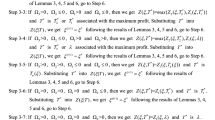Abstract
Mishra et al. (Ann Oper Res 254(1–2):165–190, 2017) proposed an EOQ model for a deteriorating seasonal product where demand was considered as a function of stock and selling price. Their model practiced preservation technology in order to control the deterioration rate. Further, shortages were allowed and two different scenarios, complete backordering and partial backordering were dealt with in individual cases. The model jointly optimized selling price, ordering frequency and investment in preservation technology under a profit maximization scenario. The problem they investigated depicts a practical real-life scenario, but the mathematical modelling is incorrect. Thus, the numerical results, special cases and managerial insights are debatable. Realizing the significant contribution of the model in question to the existing literature, we revisit the model to provide a corrected comprehensive version. The present model’s optimality has been proved mathematically. Further, the model has been validated using numerical analysis. Sensitivity analysis has been performed to test the robustness of the model.


Similar content being viewed by others
Reference
Mishra, U., Cárdenas-Barrón, L.E., Tiwari, S., Shaikh, A.A., Treviño-Garza, G.: An inventory model under price and stock dependent demand for controllable deterioration rate with shortages and preservation technology investment. Ann. Oper. Res. 254(1–2), 165–190 (2017)
Dye, C.Y., Hsieh, T.P.: An optimal replenishment policy for deteriorating items with effective investment in preservation technology. Eur. J. Oper. Res. 218(1), 106–112 (2012)
Zhang, J., Bai, Z., Tang, W.: Optimal pricing policy for deteriorating items with preservation technology investment. J. Ind. Manag. Optim. 10(4), 1261–1277 (2014)
He, Y., Huang, H.: Optimizing inventory and pricing policy for seasonal deteriorating products with preservation technology investment. J. Ind. Eng. 2013 (2013)
Hsieh, T.P., Dye, C.Y.: A production–inventory model incorporating the effect of preservation technology investment when demand is fluctuating with time. J. Comput. Appl. Math. 239, 25–36 (2013)
Author information
Authors and Affiliations
Corresponding author
Additional information
Publisher's Note
Springer Nature remains neutral with regard to jurisdictional claims in published maps and institutional affiliations.
Appendices
Appendix 1
All the second order derivatives are
Appendix 2
Lemma 1
For a fixed number of ordering frequency n, there exist a unique \(\alpha^{*}\) and \(p^{*}\) if \((2D(p)\beta - cb\lambda (\alpha )) > 0\).
The second condition for sufficiency is,
All the second order derivatives are given in “Appendix 1”.
Hence
This implies that
Appendix 3
All the second order derivatives are
Appendix 4
Lemma 2
For a fixed number of ordering frequency n, there exist a unique \(\alpha^{*}\) and \(p^{*}\) if \((D(p)\beta - cb\lambda (\alpha )) > 0\).
The second condition for sufficiency is
All the second order derivatives are given in “Appendix 3”.
Hence
This implies that
Rights and permissions
About this article
Cite this article
Priyamvada, Rini, Khanna, A. et al. An inventory model under price and stock dependent demand for controllable deterioration rate with shortages and preservation technology investment: revisited. OPSEARCH 58, 181–202 (2021). https://doi.org/10.1007/s12597-020-00474-5
Accepted:
Published:
Issue Date:
DOI: https://doi.org/10.1007/s12597-020-00474-5




